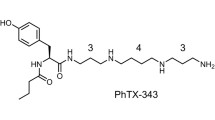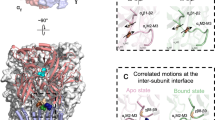Summary
-
1.
Muscle and electric organ acetylcholine receptors (AChR's) were expressed inXenopus laevis oocytes and differential effects of noncompetitive blockers on each type of receptor were analyzed using a two-electrode voltage clamp.
-
2.
The positively charged channel blockers, phencyclidine (PCP) and tetracaine, displayed a much lower potency on muscle receptor than on the electric organ receptor. The IC50 for both blockers at the elecgrocyte receptor was close to 1µM at -60 mV and even lower at more hyperpolarized voltages. In contrast, with muscle receptor IC50's were 20 to 40µM at -60 or -80 mV.
-
3.
Eupalmerin acetate, an uncharged noncompetitive inhibitor that displaces [3H]PCP from its high-affinity binding site, inhibited both receptors with a similar potency: IC50 of 4.9 and 6.4µM for electrocyte and muscle receptors, respectively. However, eupalmerin acetate affected the desensitization process in each receptor type differently and triggered an unusual biphasic response in the muscle receptor.
-
4.
These results are discussed with respect to differences in the amino acid sequences of the M2 regions of the two receptors.
-
5.
A third type of noncompetitive inhibitor, Mg2+, was also examined and it inhibited both receptors with a similar potency (IC50, 0.5-1.0 mM). However, Mg2+ appeared to act at sites other than the PCP site.
Similar content being viewed by others
References
Albuquerque, E. X., Tsai, M. C., Aronstam, R. S., Witkop, B., Eldefrawi, A. T., and Eldefrawi, M. E. (1980). Phencyclidine interactions with the ionic channel of the acetylcholine receptor and electrogenic membrane.Proc. Natl. Acad. Sci. USA 771224–1228.
Boyd, N. D., and Cohen, J. B. (1984). Desensitization of membrane-bound Torpedo acetylcholine receptor by amine noncompetitive antagonists and aliphatic alcohols: Studies of [3H]acetylcholine binding and22Na+ ion fluxes.Biochemistry 2234023–4033.
Changeux, J. P. (1990). Functional architecture and dynamics of the nicotinic acetylcholine receptor: An allosteric ligand-gated ion channel. Rita Levi-Montalcini Neuroscience Award Lecture, Fidea Research Foundation.
Changeux, J. P., Pinset, C., and Ribera, A. B. (1986). Effect of chlorpromazine and phencyclidine on mouse C2 acetylcholine receptor kinetics.J. Physiol. 378497–513.
Dani, J. A., and Eisenman, G. (1987). Monovalent and divalent cation permeation in acetylcholine receptor channels.J. Gen. Physiol.. 89959–983.
Eterović, V. A., and Hann, R. M. (1982). A puzzling picture of the acetylcholine receptor ion channel revealed by noncompetitive inhibitors.Bull. P.R. Med. Assoc. (in press).
Eterović, V. A., Hann, R. M., Ferchmin, P. A., Rodriguez, A. D., Li, L., Lee, Y. H., and McNamee, M. G. (1993). Diterpenoids from Caribbean gorgonians act as noncompetitive inhibitors of the nicotinic acetylcholine receptor.Cell. Mol. Neurobiol. 13XX-XX.
Heidmann, T., Oswald, R. E., and Changeux, J. P. (1983). Multiple sites of action for noncompetitive blockers on acetylcholine receptor rich membrane fragments from Torpedo marmorata.Biochemistry 223112–3127.
Herz, J. M., Kolb, S. J., Erlinger, T., and Schmid, E. (1991). Channel permeant cations compete selectively with noncompetitive inhibitors of the nicotinic acetylcholine receptor.J. Biol. Chem. 26616691–16698.
Imoto, K., Busch, C., Sakmann, B., Mishina, M., Konno, T., Nakai, J., Bujo, H., Mori, Y., Fukuda, K., and Numa, S. (1988). Rings of negatively charged amino acids determined the acetylcholine receptor channel conductance.Nature 335645–648.
Leonard, R. J., Charnet, P., Labarca, C., Vogelaar, N. J., Czyzyk, L., Gouin, A., Davidson, N., and Lester, H. (1991). Reverse pharmacology of the nicotinic acetylcholine receptor.N.Y. Acad. Sci. 625588–599.
Li, L., and McNamee, M. G. (1982). Modulation of nicotinic acetylcholine-receptor channel by pH—a difference in pH sensitivity ofTorpedo and mouse receptors expressed inXenopus oocytes.Cell. Mol. Neurobiol. 1283–93.
Oswald, R. E. (1983). Effect of calcium on the binding of phencyclidine to acetylcholine receptor-rich membrane fragments from Torpedo californica electroplaque.J. Neurochem. 411077–1084.
Papke, R. L., and Oswald, R. E. (1989). Mechanisms of noncompetitive inhibition of acetylcholine-induced single-channel currents.J. Physiol. 93785–811.
Sakmann, B., Methfessel, C., Mishina, M., Takahashi, T., Takai, T., Kurasaki, M., Fukuda, K., and Numa, S. (1985). Role of acetylcholine receptor subunits in gating of the channel.Nature 318538–543.
Yu, L., Leonard, R. J., Davidson, N., and Lester, H. (1991). Single-channel properties of mouse-Torpedo acetylcholine receptor hybrids expressed in Xenopus oocytes.Mol. Brain Res. 10203–211.
Author information
Authors and Affiliations
Rights and permissions
About this article
Cite this article
Eterović, V.A., Li, L., Ferchmin, P.A. et al. The ion channel of muscle and electric organ acetylcholine receptors: Differing affinities for noncompetitive inhibitors. Cell Mol Neurobiol 13, 111–121 (1993). https://doi.org/10.1007/BF00735368
Received:
Accepted:
Issue Date:
DOI: https://doi.org/10.1007/BF00735368




